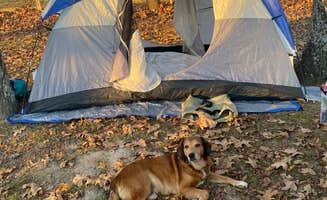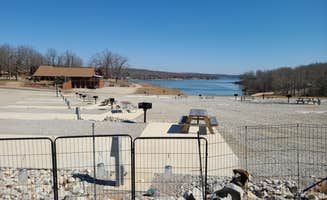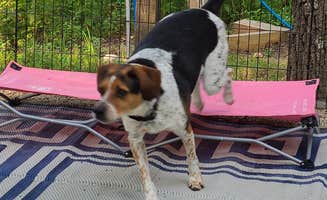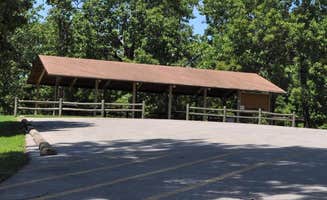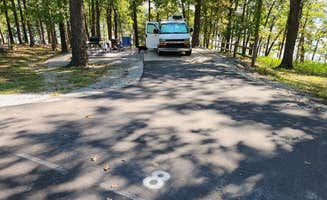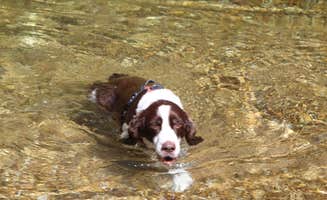Mammoth Spring, Arkansas sits at 590 feet elevation where the Spring River forms at Mammoth Spring, a natural landmark producing nine million gallons of 58°F water per hour. The area transitions between seasons dramatically, with summer temperatures reaching 90°F while winter nights often drop below freezing. Primitive camping sites along the 11 Point River connect to extensive trail networks throughout the Ozark region.
What to do
Fishing excursions: The Spring River provides consistent year-round trout fishing opportunities at Spring River Trout Shop/ Mammoth Spring Campground. "Such a beautiful place and great trout fishing, my daughter had her wedding here and we used to have our family reunion here, there is a railroad museum right by the park and a fish hatchery you can check out," shares Glen T.
Historic exploration: Within a 15-minute drive of most campgrounds, visitors can explore the Mammoth Spring State Park, complete with restored 1886 train depot and fish hatchery tours. "You can drive to Greer Spring that is a spring that comes out of a cave. It was in Backpacker Magazine as well," notes Elisha P. from Richard's Canoe Rental & Campground.
River floating: The 11 Point River offers multi-day float trips with primitive camping access points. "This has been my favorite river to float down so far. I'd suggest making the trip without kids the first time to judge your skill level. It's a bit fast and deep at the beginning," advises Elisha P.
What campers like
River access sites: Waterfront campsites provide convenient entry points for water activities. At Hardy Camper Park, visitors appreciate the direct water entry points. "Right outside of historic Hardy AR, this is a quiet campground with large grass sites, power and water and on site dump station. Hardy is a cool downtown area, but everything closes down here by 6pm. We had a beautiful site on the river!" reports Russ G.
On-site amenities: Many campgrounds feature convenience stores and rental services. "Nice and quite away from people," Vernon Z. says about Cherokee Park, while Delanie J. notes about Richard's Canoe Rental & Campground: "$10 per night, firewood, ice, and more amenities on site. The owner is so nice."
Natural springs: Several accessible blue springs provide unique swimming and photography opportunities. "I have never camped here but visit when kayaking. You can access it from the river and it is a short walk and well worth it," Michael D. shares about Boze Mill Float Camp.
What you should know
Train noise considerations: Multiple campgrounds along Spring River experience regular train traffic. "Nice place beautiful and friendly people but too many trains lol but worth it for the memories," notes Steve S. about Spring River Trout Shop.
Weather preparation: Spring and fall offer pleasant temperatures, while summer requires heat management strategies and winter camping needs extra insulation. "Our favorite time to go is in the fall when the leaves begin to change. The water may be chilly, but the views and the fishing are perfect," advises Charlotte B.
Accessibility variations: Some sites require high-clearance vehicles or short hikes. "This is a float camp along Eleven Points river. This one is accessible by 2 miles of gravel road. Several dedicated camp sites that each have fire ring, shepherds hook, picnic table," William M. explains about Boze Mill Float Camp.
River conditions: Water levels fluctuate seasonally, affecting float trip difficulty. "The convenience of having your own vehicle waiting for you after a long day of floating is worth every dime you pay for it!" Stephanie W. mentions regarding shuttle services.
Tips for camping with families
Beginner-friendly water access: Look for shallow entry points with gradual slopes for children. "Family had a lot of fun here! Fishing and swimming was great!" notes Donna M. about Spring River Trout Shop.
Educational side trips: Plan day excursions to the nearby fish hatchery and railroad museum, both offering free admission and guided tours. "The trout hatchery is interesting and educational," shares Jason W.
Swimming safety precautions: Monitor water levels before allowing children to swim, as spring-fed waters maintain a consistent cool temperature year-round. "Spring fed Spring River runs out of the ground at a tad over 50*. Cool in the summer," Jason W. adds.
Site selection strategy: Request sites away from riverbanks for families with small children, as river access points lack barriers or fencing. "We stayed in an RV lot and they let us put our teepee up and it was right on the river," mentions Ber M.
Tips from RVers
Site navigation challenges: Several campgrounds have tight turning radii and overhanging branches. "The trees are overgrown and the spots are very poorly laid out. We have a 37 foot 5er and had to do some difficult maneuvering to get turned around when we left," warns Russ G. about Jewells RV Park.
Hookup availability: Full hookup sites are limited and should be reserved weeks in advance during peak season. At Hardy Camper Park, campers find "large grass sites, power and water and on site dump station."
Downtown access: Most RV campgrounds are within 5-10 miles of supplies in either Hardy or Mammoth Spring. "Hardy is a cool downtown area, but everything closes down here by 6pm," Russ G. notes about the convenience of Hardy Camper Park's location.
Seasonal considerations: During heavy rain periods, some riverside campsites may experience soggy conditions, requiring careful site selection. Select elevated spots when possible during spring's wet season.




